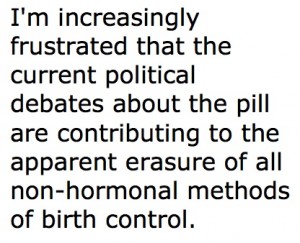In response to Rick Santorum’s recent assertion that birth control only costs “a few dollars” and therefore there shouldn’t be such a big fuss about denying insurance coverage, Mother Jones published a birth control calculator this week that estimates your lifetime costs for birth control, based on your current age. The calculator asks you to enter your age and then select your preferred method. Options include the pill, IUDs, Implanon, injections, the patch, the vaginal ring, and surgical sterilization. (It doesn’t specify sterilization for women or for men, but given the context of the current debates, I’m assuming the calculator estimates only the cost of female sterilization.) It also fails to take into account that, in reality, most women use more than one method throughout their reproductive years.

Now, I know that aside from the cost of reference books, charting supplies, and perhaps a course or two to get started, using Fertility Awareness Methods is free, but condoms and spermicide aren’t. And as NPR reported on Tuesday, it can be difficult or inconvenient to get those methods covered by health insurance. Diaphragms and cervical caps aren’t cheap either, and they both require physician visits to be properly fitted. Diaphragms last a long time, but they do need to be replaced every few years. It’s been a while since I needed one, but I’m pretty sure that my health insurance covered the cost of my diaphragm, although I had to pay out-of-pocket for the accompanying spermicide gel. In my student days, I got both at my school’s Student Health Center, covered by the student health insurance fees that we were required to pay whether we used the student health center or remained on parental insurance.
I’ve written before about my bewilderment at the diaphragm’s disappearance, but I’m increasingly frustrated that the current political debates about the pill are contributing to the apparent erasure of all non-hormonal methods of birth control. The pill has become synonymous with birth control in some quarters, without consideration of the profound implications of that swap for women’s health.
I am not opposed to the pill, by the way. I want it to be available, I think it should be covered by health insurance, and I want it to be safe. But I also want women to have complete, accurate, accessible information about all of their birth control options. And let’s get all of them covered by health insurance.



I find it hard to believe that in all the furor over medical coverage for birth control, no one is advocating that all methods – hormonal and non-hormonal – should be covered. As you say, birth control is becoming synonymous with prescribed hormonal medications – pill, patch, ring and maybe Mirena. It’s a huge problem.
The Catholics, in particular, have missed a huge opportunity to demand that religiously-centered Natural Family Planning training be covered. And it would follow that secular-based Fertility Awareness Methods be covered as well. Maybe then, sexual and reproductive health care providers, like PP and university health clinics, would get more serious about providing skilled FAM training to clients and students. If the cost of learning NFP and FAM were covered by insurance, many more women would embrace these methods. There is an up front cost to buy charting supplies and learn the method effectively from a trained instructor, but after that, as you note Liz, it’s basically free.